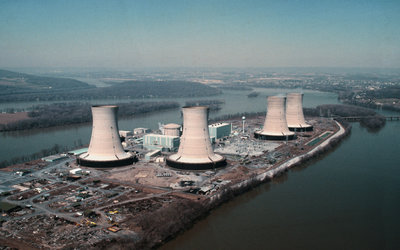Nuclear Power Safety / Security
Introduction

(click image to enlarge)
On March 28, 1979 a sequence of events took place at the TMI-2 reactor at the Three Mile Island Nuclear Power Plant near Middletown, PA that resulted in the most serious accident in U.S. commercial nuclear power plant operating history. It was later determined that, due to design deficiencies, mechanical malfunction and human error, the reactor overheated and about half of the reactor core melted. Very small amounts of radiation leaked from the reactor into the surrounding areas.
The event transformed the nuclear industry and the governmental policies regulating the industry's safety standards. Sweeping changes at the Nuclear Regulatory Commission (NRC) and its policies greatly altered the safety requirements for all nuclear power plants and the design criteria that were expected for new construction.
Accidents
There have been several accidents at nuclear power plants around the world, since nuclear power was first harnessed for peaceful uses. Of those accidents, the three most damaging and most well-known are:
- Three Mile Island
- The Three Mile Island event occurred on March 28, 1979 at the nuclear power plant on Three Mile Island, near Harrisburg, Pennsylvania, USA. It started with a loss of coolant and a partial core meltdown. It's cause has been attributed to operator errors. There was a small release of radioactive gases, but there were no deaths due to the accident.
- Chernobyl
- The Chernobyl accident occurred on April 26, 1986 at Chernobyl Raion, Kiev Oblast, Ukraininan SSR. It was a severe event, involving overheating of the reactor, a steam explosion and meltdown. It required the evacuation of 300,000 people from the city of Chernobyl. The radioactive waste was widely dispersed, spreading into parts of Europe. The accident resulted in 30 direct deaths and numerous indirect deaths due to cancer caused by released radioactive material.
- Fukushima-Daiichi
- The accident at Fukushima, Japan occurred on March 12, 2011. It resulted from flooding caused by a tsunami that was generated by a earthquake at sea. Five of the plants 6 reactors were damaged, resulting in meltdowns. The local area was evacuated. Two deaths occurred by drowning and another death occurred during the clean-up.
Security
The Nuclear Regulatory Commission is charged with formulating and enforcing standards of safety and security at U.S. nuclear power plants. The guiding criteria for the NRC in this capacity is the Energy Policy Act of 2005, which addressed several issues in light of the 9/11 attacks on the World Trade Center.
As a result of several years of study and improvement of conditions by the NRC, nuclear power plants in the USA are now much more heavily and effectively guarded against adversaries, whether their action takes the form of sabotage, theft, cybercrime or direct, violent attack.